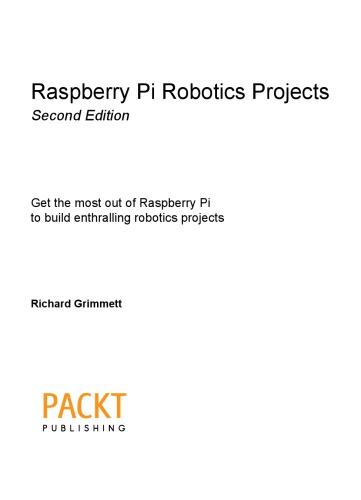

Most ebook files are in PDF format, so you can easily read them using various software such as Foxit Reader or directly on the Google Chrome browser.
Some ebook files are released by publishers in other formats such as .awz, .mobi, .epub, .fb2, etc. You may need to install specific software to read these formats on mobile/PC, such as Calibre.
Please read the tutorial at this link. https://ebooknice.com/page/post?id=faq
We offer FREE conversion to the popular formats you request; however, this may take some time. Therefore, right after payment, please email us, and we will try to provide the service as quickly as possible.
For some exceptional file formats or broken links (if any), please refrain from opening any disputes. Instead, email us first, and we will try to assist within a maximum of 6 hours.
EbookNice Team

Status:
Available0.0
0 reviews
ISBN 10: 1785280147
ISBN 13: 9781785280146
Author: Richard Grimmett
This book is for enthusiasts who want to use the Raspberry Pi to build complex robotics projects. With the aid of the step-by-step instructions in this book, you can construct complex robotics projects that can move, talk, listen, see, swim, or fly. No previous Raspberry Pi robotics experience is assumed, but even experts will find unexpected and interesting information in this invaluable guide.
1. Getting Started with Raspberry Pi
Getting started
The unboxing
Powering your board
Hooking up a keyboard, mouse, and display
Installing the operating system
Accessing the board remotely
Establishing Internet access on Raspberry Pi B+
Establishing Internet access on Raspberry Pi A+
Accessing your Raspberry Pi from your host PC
Summary
2. Programming Raspberry Pi
Basic Linux commands on Raspberry Pi
Creating, editing, and saving files on Raspberry Pi
Creating and running Python programs
Basic programming constructs on Raspberry Pi
The if statement
The while statement
Working with functions
Libraries/modules in Python
Object-oriented code
Introduction to the C/C++ programming language
Summary
3. Providing Speech Input and Output
Hooking up the hardware to make and input sound
Using Espeak to allow our projects to respond in a robotic voice
Using PocketSphinx to accept your voice commands
Interpreting commands and initiating actions
Summary
4. Adding Vision to Raspberry Pi
Connecting the USB camera to Raspberry Pi and viewing the images
Connecting the Raspberry Pi camera board and viewing the images
Downloading and installing OpenCV – a fully featured vision library
Using the vision library to detect colored objects
Summary
5. Creating Mobile Robots on Wheels
Gathering the required hardware
Using the Raspberry Pi GPIO to control a DC motor
Controlling your mobile platform programmatically using Raspberry Pi
Controlling the speed of your motors with PWM
Adding program arguments to control your platform
Making your platform truly mobile by issuing voice commands
Summary
6. Controlling the Movement of a Robot with Legs
Gathering the hardware
Connecting Raspberry Pi to the mobile platform using a servo controller
Connecting the hardware
Configuring the software
Creating a program in Linux to control the mobile platform
Making your mobile platform truly mobile by issuing voice commands
Summary
7. Avoiding Obstacles Using Sensors
Connecting Raspberry Pi to an infrared sensor using USB
Connecting a sensor using the USB interface
Connecting the IR sensor using the GPIO ADC
Connecting Raspberry Pi to a USB sonar sensor
Connecting the hardware
Using a servo to move a single sensor
Summary
8. Going Truly Mobile – The Remote Control of Your Robot
Gathering the hardware
Connecting Raspberry Pi to a wireless USB keyboard
Using the keyboard to control your project
Working remotely with your Raspberry Pi through a wireless LAN
Working remotely with your Raspberry Pi through ZigBee
Summary
9. Using a GPS Receiver to Locate Your Robot
Connecting Raspberry Pi to a USB GPS device
Accessing the USB GPS programmatically
Connecting Raspberry Pi to an RX/TX (UART) GPS device
Communicating with the RX/TX GPS programmatically
Taking a look at the GPS data
Summary
10. System Dynamics
Creating a general control structure
Using the structure of the Robot Operating System to enable complex functionalities
Summary
11. By Land, Sea, and Air
Using Raspberry Pi to sail
Getting started
Using Raspberry Pi to fly robots
Using Raspberry Pi to make the robot swim underwater
Summary
Index
raspberry pi robot projects for beginners
raspberry pi robotics projects
raspberry pi robotics for beginners
raspberry pi robotics tutorial
raspberry pi robotic projects - third edition
raspberry pi robotics book
Tags: Richard Grimmett, Raspberry, Robotics